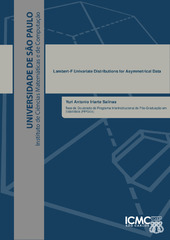| dc.contributor.author | Iriarte Salinas, Yuri Antonio | |
| dc.date.accessioned | 2022-02-14T17:58:13Z | |
| dc.date.available | 2022-02-14T17:58:13Z | |
| dc.date.issued | 2021-12-16 | |
| dc.identifier.citation | IRIARTE SALINAS, Yuri Antonio. Lambert-F univariate distributions for asymmetrical data. 2021. Tese (Doutorado em Estatística) – Universidade Federal de São Carlos, São Carlos, 2021. Disponível em: https://repositorio.ufscar.br/handle/ufscar/15596. | * |
| dc.identifier.uri | https://repositorio.ufscar.br/handle/ufscar/15596 | |
| dc.description.abstract | In this dissertation, we propose new univariate continuous distributions for modeling asymmetrical data. Initially, starting from a non-linear parametric transformation of an uniform random variable, we propose a new asymmetric one-parameter distribution that extends the uniform distribution, the so-called Lambert-uniform distribution. The transformation is expressed analytically in terms of the principal branch of the Lambert W function in such a way that the inverse transformation is expressed in terms of an exponential function. Consequently, the density function of the Lambert-uniform distribution has a simple closed form and exhibits increasing or decreasing monotonic behavior. Subsequently, based on the Lambert-uniform
distribution, we propose a new distribution generator that allows adding one shape parameter to an arbitrary baseline distribution. The added parameter allows a variety of shapes for the density function of the resulting distribution, leading to an expansion of the skewness and kurtosis ranges of the baseline distribution. We observe that the parameter induced by the generator acts as a skewness parameter when the baseline distribution is symmetric. On the other hand, when the baseline distribution has positive support, we observe that the hazard rate function of the resulting distribution corresponds to a modification in the early times of the hazard rate function of the baseline distribution. This is exemplified through the study of four special cases obtained by considering the generalized-bimodal, slash, exponential and Rayleigh distributions as baseline distributions. We discuss the parameter estimation via the maximum likelihood method and evaluate the behavior of the estimators through simulation experiments. Finally, we consider some application examples that illustrate the usefulness of the proposed distributions in different real settings. | eng |
| dc.description.sponsorship | Outra | por |
| dc.language.iso | eng | eng |
| dc.publisher | Universidade Federal de São Carlos | por |
| dc.rights | Attribution-NonCommercial-NoDerivs 3.0 Brazil | * |
| dc.rights.uri | http://creativecommons.org/licenses/by-nc-nd/3.0/br/ | * |
| dc.subject | Distribuição de referência | por |
| dc.subject | Estimador de máxima verossimilhança | por |
| dc.subject | Função densidade de probabilidade | por |
| dc.subject | Função de taxa de risco | por |
| dc.subject | Função Lambert W | por |
| dc.subject | Gerador de distribuição | por |
| dc.subject | Parâmetro de forma | por |
| dc.subject | Baseline distribution | eng |
| dc.subject | Probability density function | eng |
| dc.subject | Distribution generator | eng |
| dc.subject | Hazard rate function | eng |
| dc.subject | Lambert W function | eng |
| dc.subject | Maximum likelihood estimator | eng |
| dc.subject | Shape parameter | eng |
| dc.title | Lambert-F univariate distributions for asymmetrical data | eng |
| dc.title.alternative | Distribuições univariadas de Lambert-F para dados assimétricos | por |
| dc.type | Tese | por |
| dc.contributor.advisor1 | Andrade Filho, Mario de Castro | |
| dc.contributor.advisor1Lattes | http://lattes.cnpq.br/6518161034709249 | por |
| dc.description.resumo | Nesta tese, propomos novas distribuições contínuas univariadas para modelar dados assimétricos. Inicialmente, partindo de uma transformação paramétrica não linear de uma variável aleatória uniforme, propomos uma nova distribuição assimétrica de um parâmetro que estende a distribuição uniforme, a chamada distribuição Lambert-uniforme. A transformação é expressa analiticamente em termos do ramo principal da função Lambert W de tal forma que a transformação inversa é expressa em termos de uma função exponencial. Conseqüentemente, a função densidade da distribuição Lambert-uniforme tem uma forma fechada simples e exibe um comportamento monótono crescente ou decrescente. Posteriormente, com base na distribuição Lambert-uniforme, propomos um novo gerador de distribuição que permite adicionar um parâmetro de forma a uma distribuição de referência arbitrária. O parâmetro adicionado permite uma variedade de formas para a função de densidade da distribuição resultante, levando a uma expansão dos intervalos de assimetria e curtose da distribuição de referência. Observamos que o parâmetro induzido pelo gerador atua como parâmetro de assimetria quando a distribuição de referência é simétrica. Por outro lado, quando a distribuição de referência tem suporte positivo, observamos que a função taxa de risco da distribuição resultante corresponde a uma modificação nos tempos iniciais da função taxa de risco da distribuição de referência. Isso é exemplificado através do estudo de quatro casos especiais obtidos considerando as distribuições bimodal generalizada, slash, exponencial e Rayleigh como distribuições de referência. Discutimos a estimação de parâmetros pelo método de máxima verossimilhança e avaliamos o comportamento dos estimadores por meio de experimentos de simulação. Finalmente, consideramos alguns exemplos de aplicação que ilustram a utilidade das distribuições propostas em diferentes ambientes reais. | por |
| dc.publisher.initials | UFSCar | por |
| dc.publisher.program | Programa Interinstitucional de Pós-Graduação em Estatística - PIPGEs | por |
| dc.subject.cnpq | CIENCIAS EXATAS E DA TERRA::PROBABILIDADE E ESTATISTICA::ESTATISTICA::ANALISE DE DADOS | por |
| dc.subject.cnpq | CIENCIAS EXATAS E DA TERRA::PROBABILIDADE E ESTATISTICA::ESTATISTICA::INFERENCIA PARAMETRICA | por |
| dc.description.sponsorshipId | CONICYT PAI/INDUSTRIA 79090016, Chile | por |
| dc.publisher.address | Câmpus São Carlos | por |
| dc.contributor.authorlattes | http://lattes.cnpq.br | por |


